Lenovo Ideapad L340 (15″) review – one of many successors to the Ideapad 330
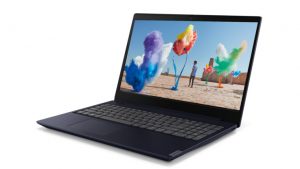 So, perhaps you need an all-rounder notebook – build for office work, student stuff and multimedia, while at the same time being capable of doing some minor gaming. Moreover, your budget is very strict and you can’t afford to throw more than 1000 bucks for your every-day driver. Well, in this case, the Ideapad L340 (15″) might just be the right laptop for you.
So, perhaps you need an all-rounder notebook – build for office work, student stuff and multimedia, while at the same time being capable of doing some minor gaming. Moreover, your budget is very strict and you can’t afford to throw more than 1000 bucks for your every-day driver. Well, in this case, the Ideapad L340 (15″) might just be the right laptop for you.
It comes in two major configurations – one with AMD processors and one with Intel CPUs. Let’s disclose that we have tested the Intel-equipped version, so you might see a difference in some of the results if you own an AMD model. Nevertheless, in terms of a display, the top-end model goes with a Full HD TN panel, which is a bummer.
You can check the prices and configurations in our Specs System: https://laptopmedia.com/series/lenovo-ideapad-l340-15/
Contents
Specs Sheet
- HDD/SSD
- up to 2000GB SSD + up to 2000GB HDD
- M.2 Slot
- 1x 2280 M.2 NVMe slot See photo
- RAM
- up to 20GB
- OS
- Windows 10 Home, Windows 10 Pro, No OS
- Battery
- 36Wh, 3-cell, 36Wh, 3-cell
- Body material
- Plastic / Polycarbonate
- Dimensions
- 363 x 254.6 x 22.9 mm (14.29" x 10.02" x 0.90")
- Weight
- 2.20 kg (4.9 lbs)
- Ports and connectivity
- 1x USB Type-C
- 3.2 Gen 1 (5 Gbps)
- 2x USB Type-A
- 3.2 Gen 1 (5 Gbps)
- HDMI
- 1.4b
- Ethernet LAN
- 10/100/1000 Mbit/s
- Wi-Fi
- 802.11ac
- Bluetooth
- 4.2
- Audio jack
- 3.5 mm combo
- Features
- Fingerprint reader
- Web camera
- HD
- Backlit keyboard
- Microphone
- Monaural Microphone
- Speakers
- 2x 1.5W, Dolby Audio
- Optical drive
- optional
- Security Lock slot
All Lenovo Ideapad L340 (15″) configurations
What’s in the box?
Inside the box, there are the laptop, some paper manuals, and a 65W power brick, which attaches directly to the plug on the wall, rather than using a power cable.
Design and construction
On the outside, the laptop looks really good, honestly. It has a glossy, brushed lookalike lid, a base that painted in a similar fashion and a matte bottom plate. Sadly, the entire body of the Ideapad L340 (15″) is made out of plastic, so you have to be extremely careful if you don’t like scratching or damaging your tech. Its profile is 22.9mm and it weighs 2.20 kg – averagely sized device for 2019.
Indeed, the laptop lacks innovation and lacks a feature like the ErgoLift hinge of the VivoBook S15 S530 and S532 but on the bright side, its lid can be opened with a single hand. Additionally, above the display, you can see that the camera has its own lid, that Lenovo call the “TrueBlock Privacy Shutter”. If we look past the fancy name we are going to see a piece of plastic that is mounted on a lever that moves on top and away from the camera.
Let’s take a look at the base, shall we? It is the home of a key player – the keyboard (the pun is intended). We are really happy with the size of the keycaps. However, everything else about it just … sucks. In terms of key travel, it is very shallow and on top of that, it lacks the click to it. This results in an overall discomfort in use.
On the other hand, the touchpad feels responsive and fast, although, the surface is not what we would call premium and it bends pretty substantially when you press on the bottom edges.
Turning the laptop upside-down reveals the ventilation grills. There are no speakers to be seen here because they are placed on the chamfered side on left and right sides of the laptop.
Ports
In terms of connectivity, you can see that all of the ports are placed on the left side of the device. They start off with the barrel-style plug, an RJ-45 connector, an HDMI port, two USB Type-A 3.1 (Gen. 2) ports, an audio jack, as well as a USB Type-C 3.1 (Gen. 2) port. However, this is not it! Only for the old school – there is a DVD-RW drive on the right side. You can definitely enjoy some of the FIFA 2005 action that you still have on CD laying around.
Disassembly, upgrade options and maintenance
This device follows the trend of recent years – no service lid but fewer screws. The first thing to do is to remove the screw that holds the optical drive in place. After that just pull the drive out of its slot and remove the rest of the screws. Then, pop the bottom panel with a plastic pry tool and you should be able to easily lift it from the chassis.
As you can see, the cooling is comprised of only one heat pipe. Frankly, it is so thick that there should be no problem for it to cool down both of the chips. Additionally, the fan that Lenovo has put is pretty massive for a budget multimedia device.
In terms of upgradability, there is only one RAM DIMM that supports up to 16GB of DDR4 memory. Additionally, the single-channel nature means it is going to be a little slower than a possible dual channel one. Furthermore, there is one M.2 NVMe slot that supports both PCIe and SATA drives and an additional SATA slot for 2.5″ drives.
Lastly, there is the battery, which has a very modest capacity – 36Wh.
Display quality
Lenovo Ideapad L340 (15) is equipped with a Full HD TN panel with a model number BOE NT156FHM-N61. Its diagonal is 15.6″ (39.62 cm), and the resolution 1920 х 1080 pixels. The screen ratio is 16:9, and we are looking at a pixel density of – 142 ppi, and a pitch of 0.18 х 0.18 mm. The screen turns into Retina when viewed at distance equal to or greater than 60cm (24″) (from this distance one’s eye stops differentiating the separate pixels, and it is normal for looking at a laptop).
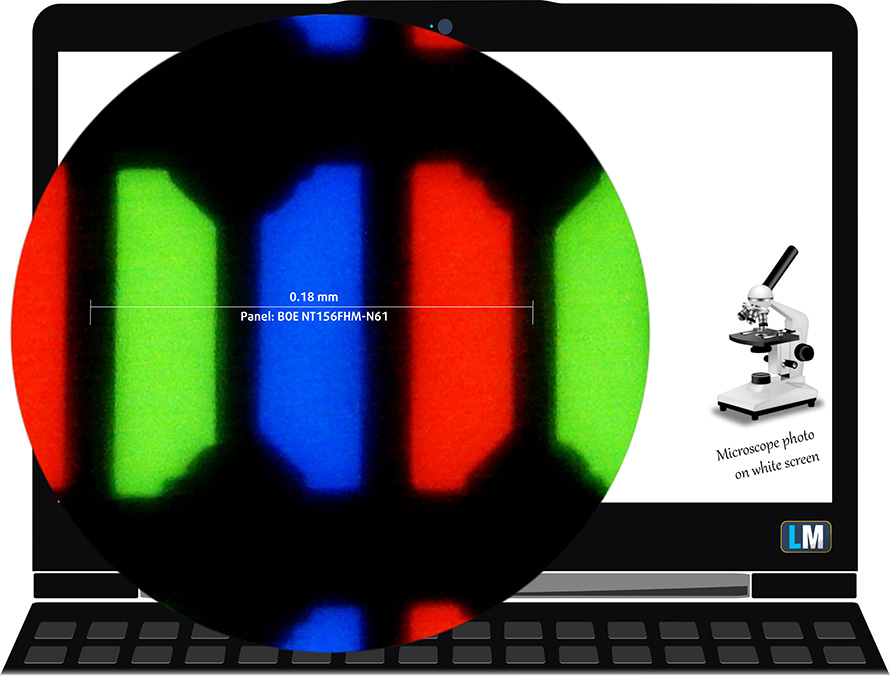
As expected from a TN panel – the viewing angles are terrible. We offer images at 45° to evaluate image quality.

The measured maximum brightness of 236 nits in the middle of the screen and 227 nits as an average for the whole area, with a maximum deviation of 8%. The Correlated Color Temperature on a white screen is 7060K – colder than the optimal for the sRGB standard of 6500K.
In the illustration below you can see how the display performs from a uniformity perspective. In other words, the leakage of light from the light source.
Values of dE2000 over 4.0 should not occur, and this parameter is one of the first you should check if you intend to use the laptop for color-sensitive work. The contrast ratio is poor – 230:1.
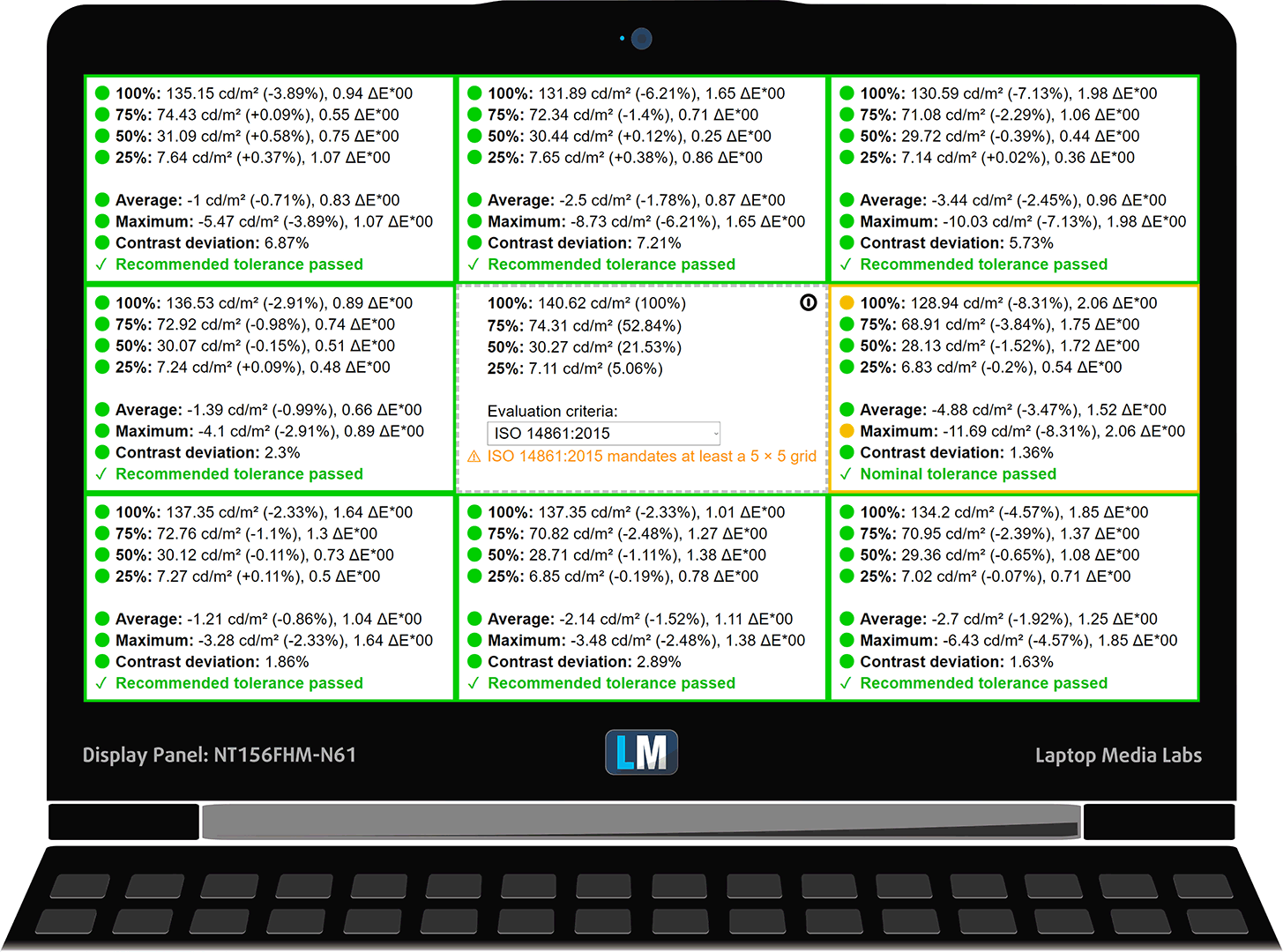
To make sure we are on the same page, we would like to give you a little introduction to the sRGB color gamut and the Adobe RGB. To start, there’s the CIE 1976 Uniform Chromaticity Diagram that represents the visible specter of colors by the human eye, giving you a better perception of the color gamut coverage and the color accuracy.
Inside the black triangle, you will see the standard color gamut (sRGB) that is being used by millions of people in HDTV and on the web. As for the Adobe RGB, this is used in professional cameras, monitors, etc for printing. Basically, colors inside the black triangle are used by everyone and this is the essential part of the color quality and color accuracy of a mainstream notebook.
Still, we’ve included other color spaces like the famous DCI-P3 standard used by movie studios, as well as the digital UHD Rec.2020 standard. Rec.2020, however, is still a thing of the future and it’s difficult for today’s displays to cover that well. We’ve also included the so-called Michael Pointer gamut, or Pointer’s gamut, which represents the colors that naturally occur around us every day.
The yellow dotted line shows Lenovo Ideapad L340 (15)’s color gamut coverage.
Its display covers 50% of the sRGB/ITU-R BT.709 (web/HDTV standard) in CIE1976.
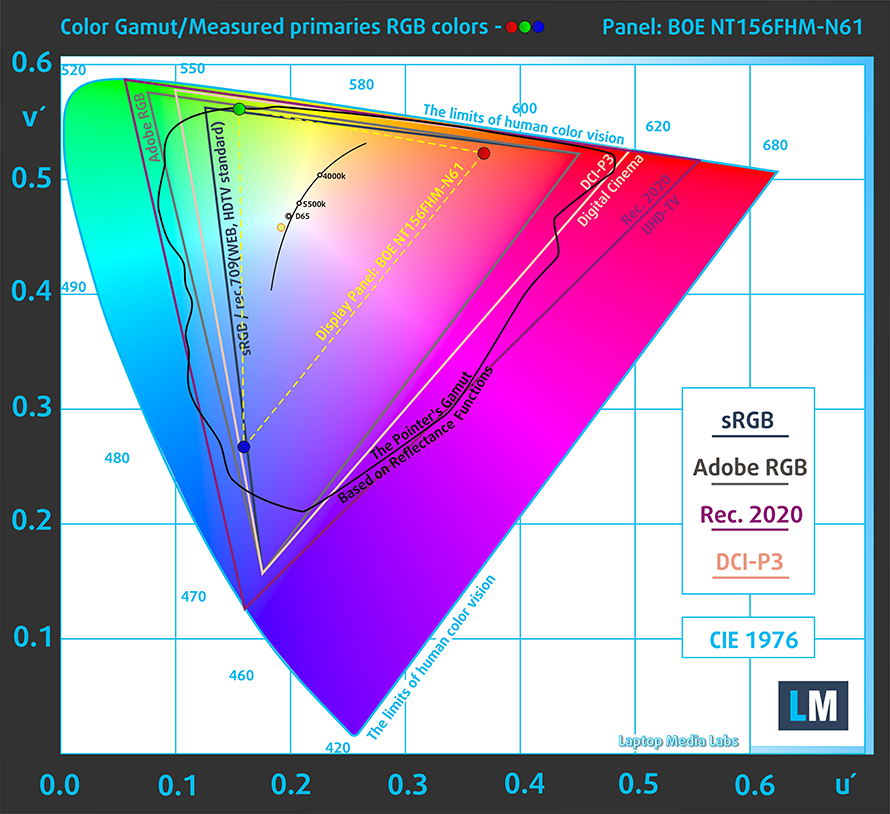
Our “Design and Gaming” profile delivers optimal color temperature (6500K) at 140 cd/m2 luminance and sRGB gamma mode.
We tested the accuracy of the display with 24 commonly used colors like light and dark human skin, blue sky, green grass, orange, etc. You can check out the results at factory condition and also, with the “Design and Gaming” profile.
Below you can compare the scores of Lenovo Ideapad L340 (15) with the default settings (left), and with the “Gaming and Web design” profile (right).
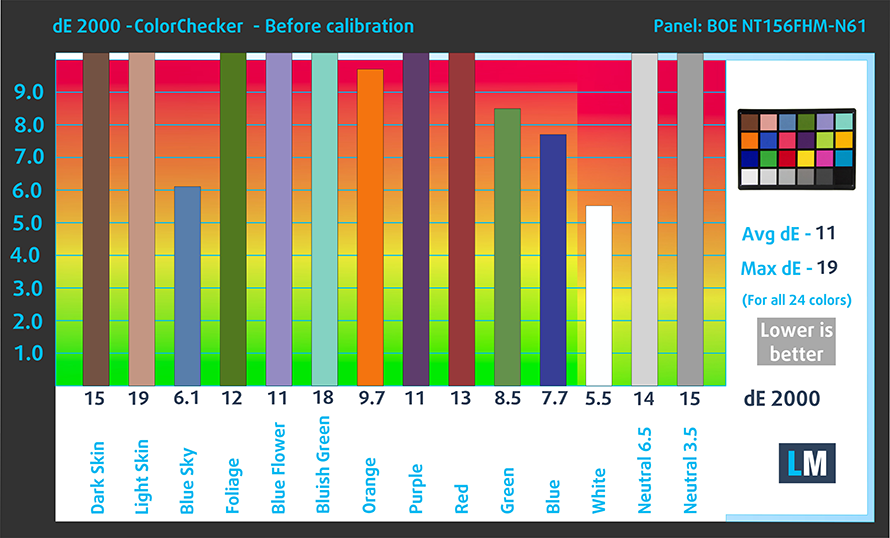
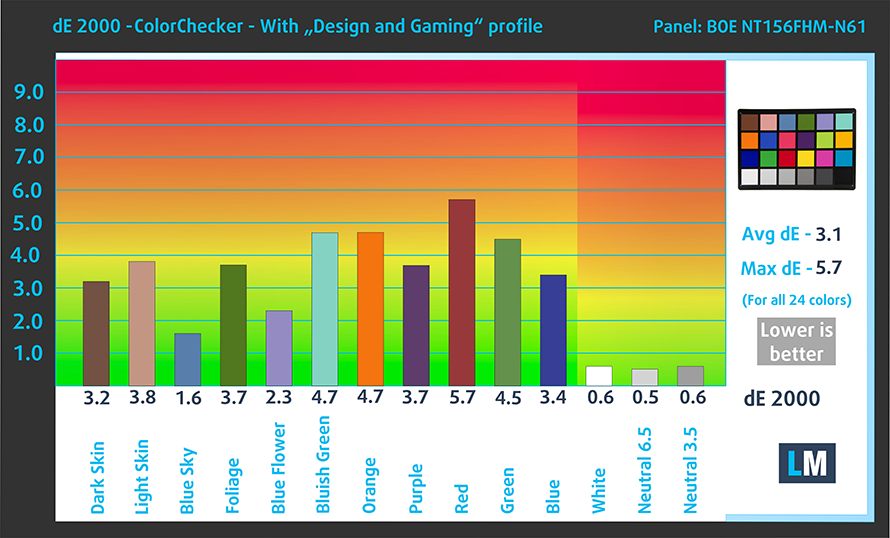
The next figure shows how well the display is able to reproduce really dark parts of an image, which is essential when watching movies or playing games in low ambient light.
The left side of the image represents the display with stock settings, while the right one is with the “Gaming and Web Design” profile activated. On the horizontal axis, you will find the grayscale and on the vertical axis – the luminance of the display. On the two graphs below you can easily check for yourself how your display handles the darkest nuances but keep in mind that this also depends on the settings of your current display, the calibration, the viewing angle, and the surrounding light conditions.
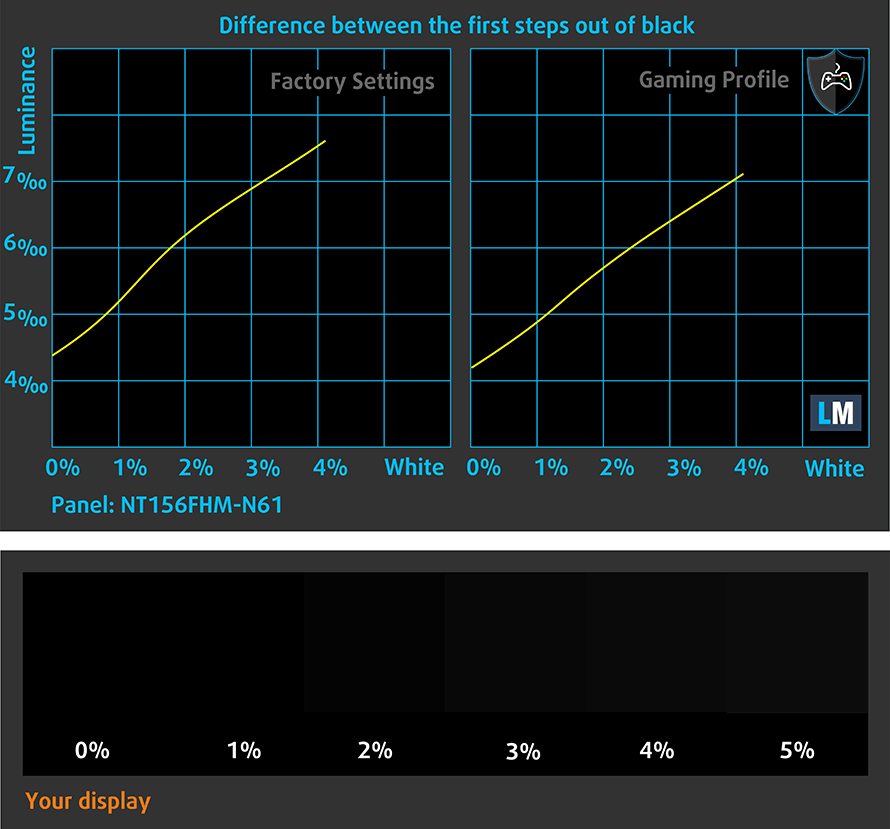
Response time (Gaming capabilities)
We test the reaction time of the pixels with the usual “black-to-white” and “white-to-black” method from 10% to 90% and vice versa.
We recorded Fall Time + Rise Time = 11 ms.
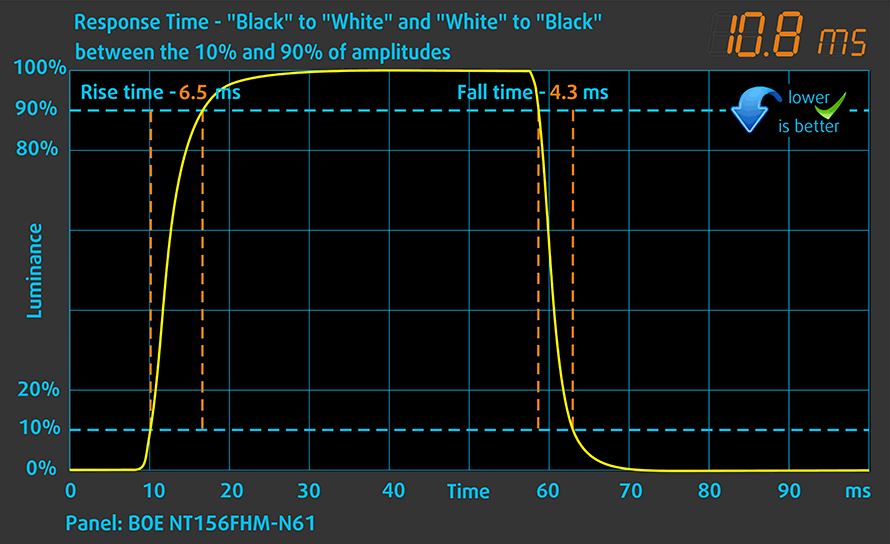
PWM (Screen flickering)
Pulse-width modulation (PWM) is an easy way to control monitor brightness. When you lower the brightness, the light intensity of the backlight is not lowered, but instead turned off and on by the electronics with a frequency indistinguishable to the human eye. In these light impulses, the light/no-light time ratio varies, while brightness remains unchanged, which is harmful to your eyes. You can read more about that in our dedicated article on PWM.
Lenovo Ideapad L340 (15) doesn’t use PWM to regulate its brightness levels. This makes it comfortable for long working periods, without being harmful in this aspect.
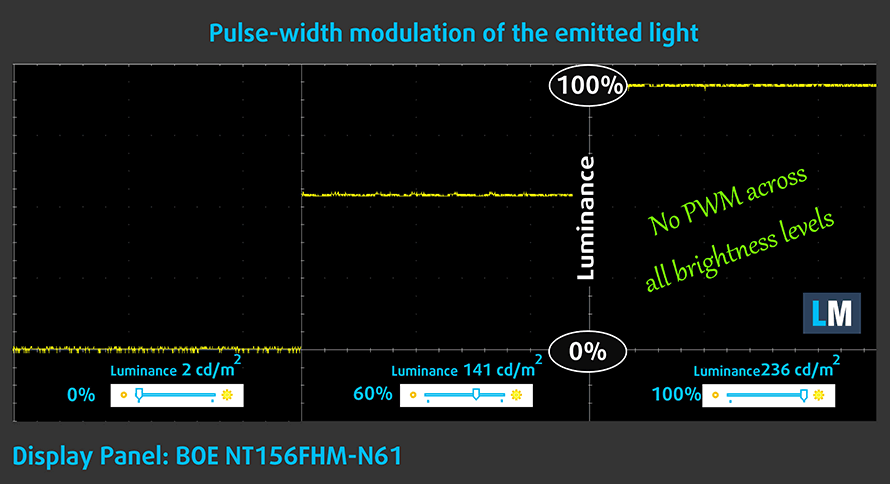
Blue light emissions
Installing our Health-Guard profile not only eliminates PWM but also reduces the harmful Blue Light emissions while keeping the colors of the screen perceptually accurate. If you’re not familiar with the Blue light, the TL;DR version is – emissions that negatively affect your eyes, skin and your whole body. You can find more information about that in our dedicated article on Blue Light.
Conclusion
Lenovo Ideapad L340 (15″) has a TN panel with a Full HD resolution, fast reactions time and comfortable backlight in terms of PWM. On the downside, it has terrible viewing angles, poor contrast ratio, and mediocre color coverage.
Buy our profiles
Since our profiles are tailored for each individual display model, this article and its respective profile package are meant for Lenovo Ideapad L340 (15) configurations with 15.6″ FHD TN BOE NT156FHM-N61 (BOE0812).
*Should you have problems with downloading the purchased file, try using a different browser to open the link you’ll receive via e-mail. If the download target is a .php file instead of an archive, change the file extension to .zip or contact us at [email protected].
Read more about the profiles HERE.
In addition to receiving efficient and health-friendly profiles, by buying LaptopMedia's products you also support the development of our labs, where we test devices in order to produce the most objective reviews possible.

Office Work
Office Work should be used mostly by users who spend most of the time looking at pieces of text, tables or just surfing. This profile aims to deliver better distinctness and clarity by keeping a flat gamma curve (2.20), native color temperature and perceptually accurate colors.

Design and Gaming
This profile is aimed at designers who work with colors professionally, and for games and movies as well. Design and Gaming takes display panels to their limits, making them as accurate as possible in the sRGB IEC61966-2-1 standard for Web and HDTV, at white point D65.

Health-Guard
Health-Guard eliminates the harmful Pulse-Width Modulation (PWM) and reduces the negative Blue Light which affects our eyes and body. Since it’s custom tailored for every panel, it manages to keep the colors perceptually accurate. Health-Guard simulates paper so the pressure on the eyes is greatly reduced.
Get all 3 profiles with 33% discount
Sound
Lenovo Ideapad L340 (15) has an average sound quality. Nevertheless, its low, mid and high tones are clear of deviations.
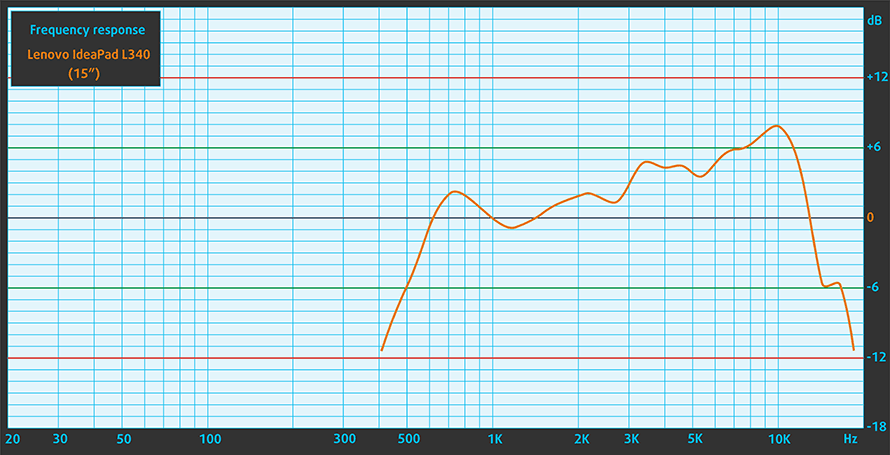
Drivers
You can download all of the drivers and utilities for the Ideapad L340 (15″) from here: https://pcsupport.lenovo.com/us/en/products/laptops-and-netbooks/ideapad-l-series-laptop/l340-15iwl
Battery
Now, we conduct the battery tests with Windows Better performance setting turned on, screen brightness adjusted to 120 nits and all other programs turned off except for the one we are testing the notebook with. Certainly, the battery size is not one of the Ideapad L340 (15″)’s strong points – 36Wh.
However, we find the screen on times during Web browsing and video playback to be respectable – around 6 hours and a half and just shy of 7 hours, respectively.
In order to simulate real-life conditions, we used our own script for automatic web browsing through over 70 websites.

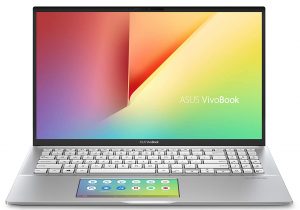
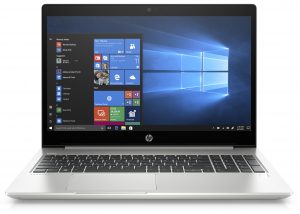
For every test like this, we use the same video in HD.



CPU options
The Lenovo Ideapad L340 (15″) comes in variants with either Intel or AMD chipsets. On the Intel side, you can choose from the Pentium Gold 5405U, Core i3-8145U or the Core i5-8265U, while the AMD options are pretty straightforward – Ryzen 3 3200U or the Ryzen 5 3500U.
Results are from the Cinebench 20 CPU test (the higher the score, the better)
Results are from our Photoshop benchmark test (the lower the score, the better)
GPU options
This laptop can be purchased with a dedicated NVIDIA GeForce MX230 graphics card. If you opt away from it, then you get the respective integrated solutions from Intel and AMD.s
Results are from the 3DMark: Fire Strike (Graphics) benchmark (higher the score, the better)
Results are from the Unigine Superposition benchmark (higher the score, the better)
Gaming tests

| CS:GO | HD 1080p, Low (Check settings) | HD 1080p, Medium (Check settings) | HD 1080p, MAX (Check settings) |
|---|---|---|---|
| Average FPS | 73 fps | 65 fps | 57 fps |

| DOTA 2 | HD 1080p, Low (Check settings) | HD 1080p, Normal (Check settings) | HD 1080p, High (Check settings) |
|---|---|---|---|
| Average FPS | 76 fps | 61 fps | 48 fps |
Temperatures and comfort
Max CPU load
In this test we use 100% on the CPU cores, monitoring their frequencies and chip temperature. The first column shows a computer’s reaction to a short load (2-10 seconds), the second column simulates a serious task (between 15 and 30 seconds), and the third column is a good indicator of how good the laptop is for long loads such as video rendering.
Average core frequency (base frequency + X); CPU temp.
| Intel Core i5-8265U (15W TDP) | 0:02 – 0:10 sec | 0:15 – 0:30 sec | 10:00 – 15:00 min |
|---|---|---|---|
| Lenovo Ideapad L340 (15″) | 3.27 GHz (B+104%)@ 72°C | 1.99 GHz (B+24%)@ 60°C | 2.01 GHz (B+26%)@ 65°C |
| ASUS VivoBook S15 S532 | 2.96 GHz (B+85%) @ 75°C | 2.95 GHz (B+84%) @ 90°C | 2.17 GHz (B+36%) @ 68°C |
| ASUS VivoBook S15 S530 | 2.99 GHz (B+87%) @ 77°C | 2.99 GHz (B+87%) @ 87°C | 2.29 GHz (B+43%) @ 71°C |
| Lenovo ThinkBook 13s | 2.76 GHz (B+73%)@ 75°C | 2.74 GHz (B+71%)@ 84°C | 2.11 GHz (B+32%)@ 74°C |
| Lenovo ThinkPad T490s | 3.43 GHz (B+114%)@ 91°C | 2.69 GHz (B+68%)@ 91°C | 2.19 GHz (B+37%)@ 80°C |
| HP ProBook 450 G6 | 2.69 GHz (B+59%)@ 64°C | 2.53 GHz (B+60%)@ 68°C | 2.09 GHz (B+31%)@ 71°C |
Quite obviously, the cooling of the Lenovo Ideapad L340 (15″) is more than sufficient enough to cool down the Core i5-8265U. However, apparently, the manufacturer has chosen to keep temperatures even further down, in order to promote longevity and introduce less heat into the chassis, whatsoever. This is completely opposite to what they achieved with the ThinkPad T490s. Weirdly, the Ideapad L340 (15″) dropped its frequencies down from the respectable 3.27 GHz to 1.99 GHz in only 20-30 seconds after the test has started. It is particularly interesting because the temperatures never exceeded 72C and after the throttling, they got down to 60C. This means we are seeing power throttling and not a thermal one.
Real-life gaming
| NVIDIA GeForce MX230 | GPU frequency/ Core temp (after 2 min) | GPU frequency/ Core temp (after 30 min) |
|---|---|---|
| Lenovo Ideapad L340 (15″) | 1632 MHz @ 69°C | 1532 MHz @ 69°C |
| Lenovo Ideapad C340 (15″) | 1658 MHz @ 74°C | 1300 MHz @ 64°C |
Certainly, the Ideapad L340 (15″) is fully capable to cool down the GeForce MX230. It appears to be much more effective than the Ideapad C340 in this aspect, as well.
Comfort during full load
The outer body of the laptop wasn’t that hot, but we measured a maximum temperature of just over 42C.


Verdict
Ideapad L340 (15″) is basically the successor to Ideapad 330 – a budget laptop that leaves some mixed impressions on whether it is worth it, or it is just the next cheapo. However, in 2019, Lenovo did something interesting to the Ideapad 330. It took it, and it separated it into branches. First, there is the Ideapad L340 (15″), which may be considered as the main successor to the line. Then, there is the Ideapad L340 Gaming (15″) which is basically, the Ideapad L340 (15″) on steroids, and finally, there is the Ideapad S340, which is more or less a successor to the Ideapad 330s.
One thing can be told for sure – the Ideapad L340 (15″) certainly looks more modern than its predecessor. It now has relatively narrow bezels, thin and light body and great design. However, it is still not too polished. Not only performance-wise, but also in terms of features and overall quality of the device.
First, let’s start with the performance. In day-to-day tasks, the laptop performs really well – it is snappy and you won’t notice stuttering. If you are going to put some substantial stress on it, though, expect the clock speeds to go down. This is not because of poor thermals, but because of the super-conservative approach from Lenovo. In fact, we are pretty confident that the cooling can sustain more than 3.00 GHz for a relatively long period of time, rather than the 10-15 seconds it does.
It utilizes a 1080p TN panel (BOE NT156FHM-N61 (BOE0812)), which as you may expect, has terrible viewing angles and contrast ratio. Additionally, it covers only 50% of sRGB and its colors were way off until we installed our Gaming and Web design profile. On the bright side, it doesn’t use PWM to adjust its brightness level and the panel itself is pretty fast in terms of reaction times.
Again, if you use it daily, you would find the I/O to suit you well, even though it lacks an SD card reader and Thunderbolt connectivity. On the bright side – it is equipped with an optical drive. However, we strongly recommend using an external keyboard for this laptop. Its own is just too shallow and mushy, which takes away from the pleasure of typing.
Not only that, but the use of an external display is also preferable. Not that its TN panel is terrible but it is not the best either with its poor viewing angles and mediocre contrast ratio. At least, its battery is not that bad. The battery life was pretty good for a 36Wh unit – 6 hours and a half of Web browsing and around 7 hours of video playback.
Despite the low price, we feel that Lenovo is still asking too much money for this device. We would personally go for the VivoBook S15 S530 – a one-year-old laptop, but it offers you a more stable performance as well as a better keyboard and an IPS panel for relatively the same money.
Pros
- Stylish design
- Great cooling capacity
- Energy efficient
- DVD-RW drive on board
- It doesn’t use PWM to adjust its brightness levels, and has fast reaction times (BOE NT156FHM-N61 (BOE0812))
Cons
- Uncomfortable keyboard
- All-plastic build
- Conservative approach towards performance
- No IPS panel options
- Its display has uncomfortable viewing angles and contrast ratio (BOE NT156FHM-N61 (BOE0812))
- The colors of the screen are way off (our Gaming and Web design profile fixes that) (BOE NT156FHM-N61 (BOE0812))
You can check the prices and configurations in our Specs System: https://laptopmedia.com/series/lenovo-ideapad-l340-15/
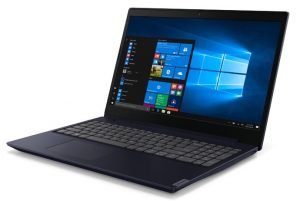
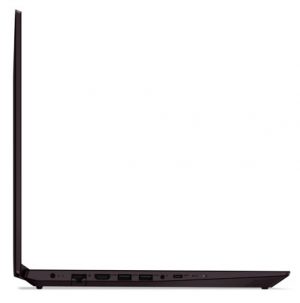
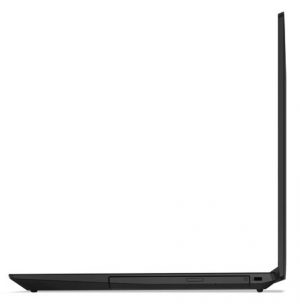
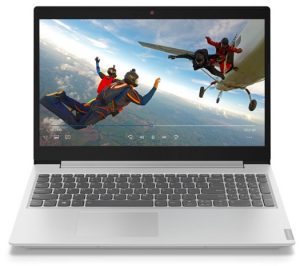
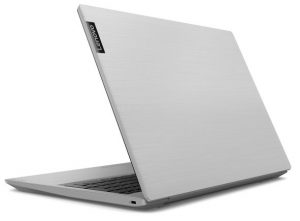

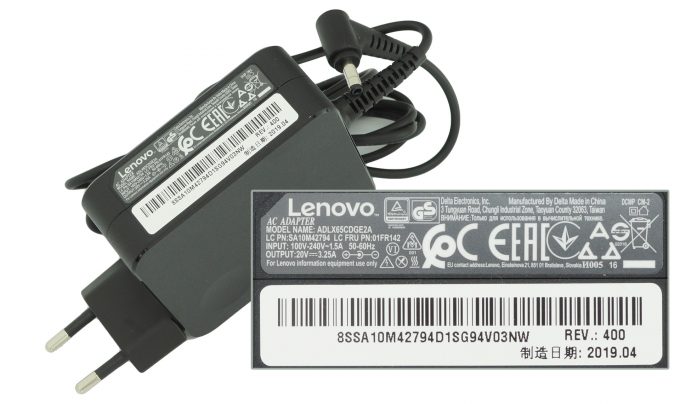
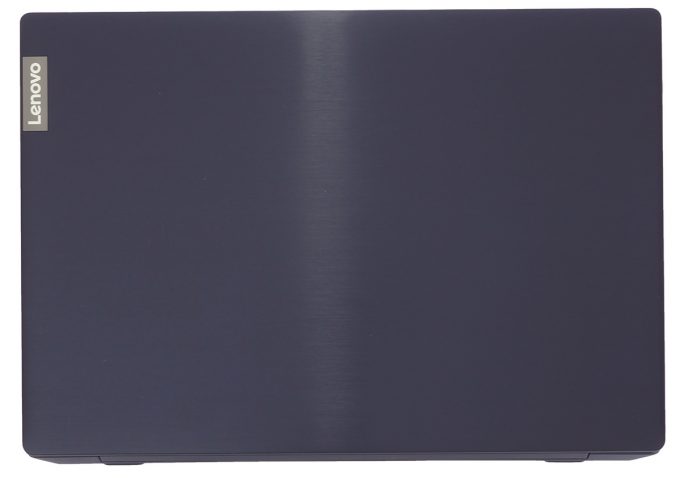
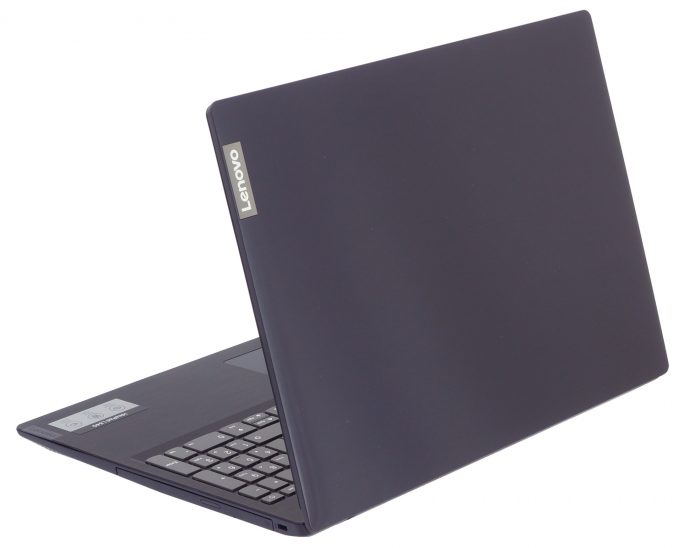
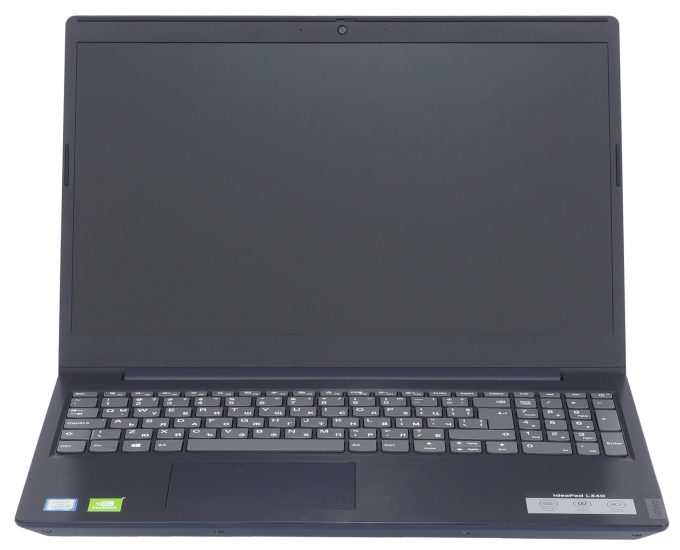
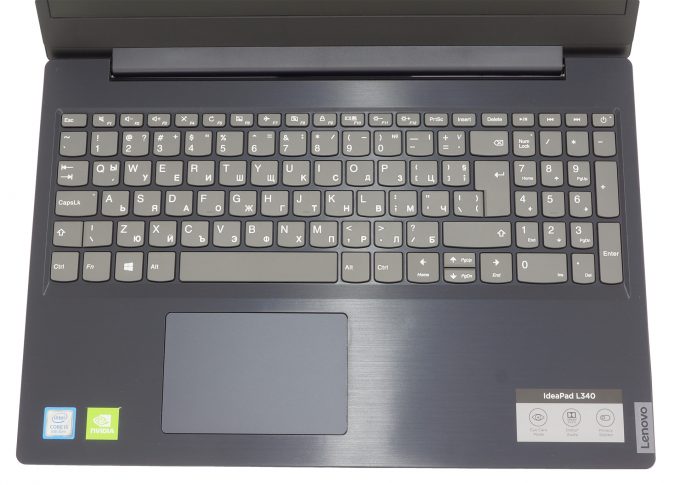
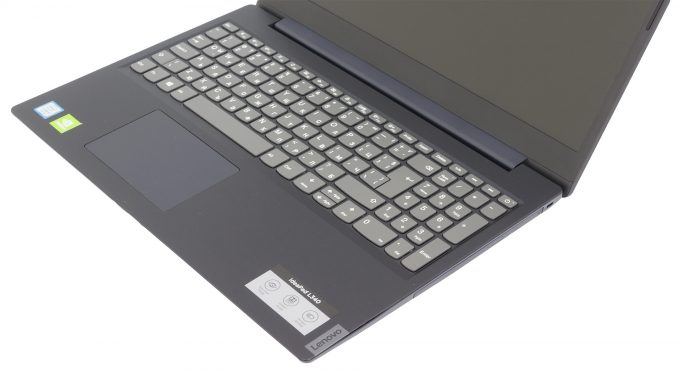
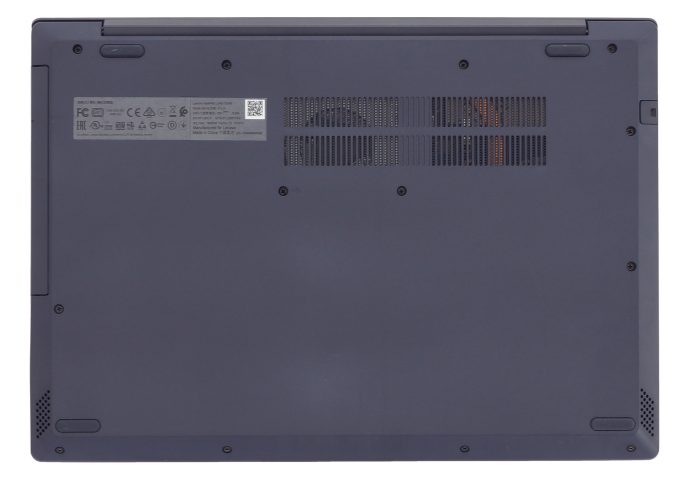


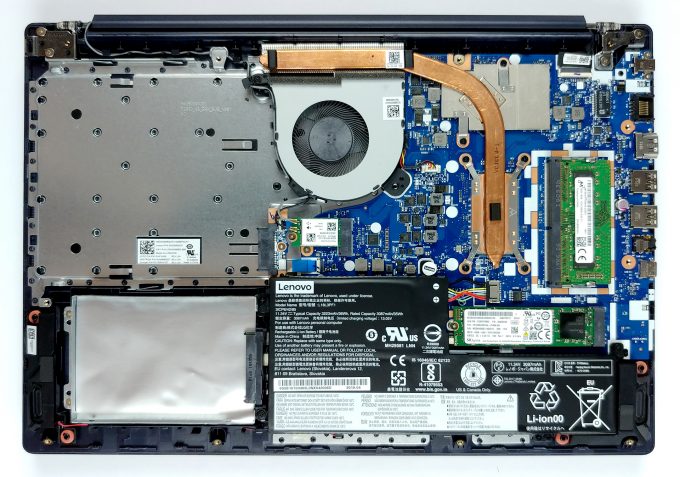
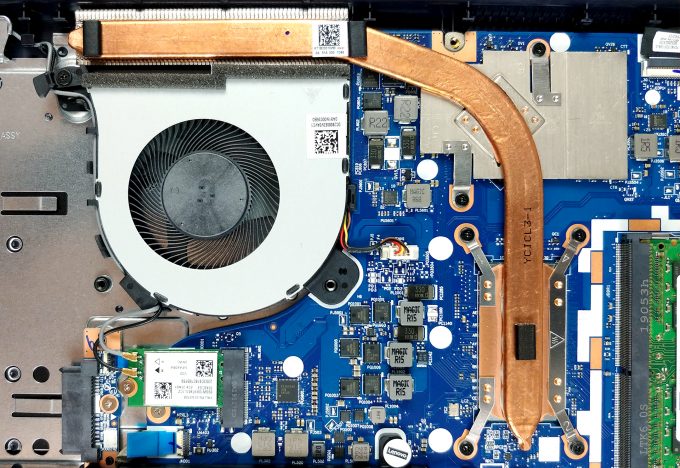
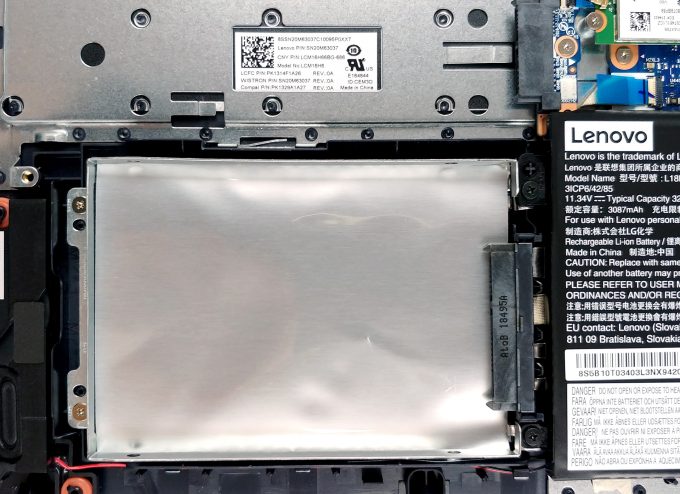

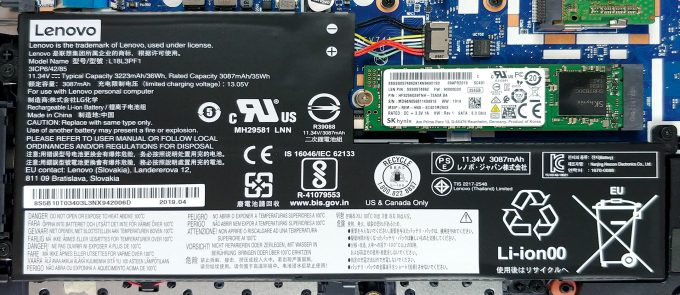


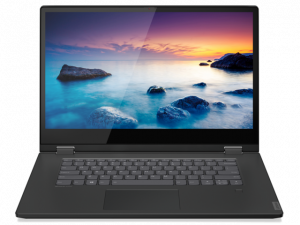








Over here in SG, the L340 is much cheaper than the S530.
yes, but about the quality? in Australia, this laptop is not great with many shortcomings.
I just ordered a Ryzen 5 3500u model with 256GB SSD and 4GB onboard soldered RAM with Lenovo Malaysia for RM1600. To get dual channel (limited to 4GB) memory with this device, you must add the onboard soldered RAM when configuring, else there’s no more chance for it. They don’t allow me to further add RAM module if I opted for the onboard 4GB, FHD screen & Ryzen 5, but that’s not a big deal as I can always add it for a cheaper price out there. Lenovo always had these weird configuration limitations, and it really does ruined many… Read more »
good review. in addition to the above. poor battery life 9even when idle) which makes this laptop at the bottom of my list. Not a good buy.
very slow too slow, I had the 330 it was faster